 Afrikaans
Afrikaans  Albanian
Albanian  Amharic
Amharic  Arabic
Arabic  Armenian
Armenian  Azerbaijani
Azerbaijani  Basque
Basque  Belarusian
Belarusian  Bengali
Bengali  Bosnian
Bosnian  Bulgarian
Bulgarian  Catalan
Catalan  Cebuano
Cebuano  Corsican
Corsican  Croatian
Croatian  Czech
Czech  Danish
Danish  Dutch
Dutch  English
English  Esperanto
Esperanto  Estonian
Estonian  Finnish
Finnish  French
French  Frisian
Frisian  Galician
Galician  Georgian
Georgian  German
German  Greek
Greek  Gujarati
Gujarati  Haitian Creole
Haitian Creole  hausa
hausa  hawaiian
hawaiian  Hebrew
Hebrew  Hindi
Hindi  Miao
Miao  Hungarian
Hungarian  Icelandic
Icelandic  igbo
igbo  Indonesian
Indonesian  irish
irish  Italian
Italian  Japanese
Japanese  Javanese
Javanese  Kannada
Kannada  kazakh
kazakh  Khmer
Khmer  Rwandese
Rwandese  Korean
Korean  Kurdish
Kurdish  Kyrgyz
Kyrgyz  Lao
Lao  Latin
Latin  Latvian
Latvian  Lithuanian
Lithuanian  Luxembourgish
Luxembourgish  Macedonian
Macedonian  Malgashi
Malgashi  Malay
Malay  Malayalam
Malayalam  Maltese
Maltese  Maori
Maori  Marathi
Marathi  Mongolian
Mongolian  Myanmar
Myanmar  Nepali
Nepali  Norwegian
Norwegian  Norwegian
Norwegian  Occitan
Occitan  Pashto
Pashto  Persian
Persian  Polish
Polish  Portuguese
Portuguese  Punjabi
Punjabi  Romanian
Romanian  Russian
Russian  Samoan
Samoan  Scottish Gaelic
Scottish Gaelic  Serbian
Serbian  Sesotho
Sesotho  Shona
Shona  Sindhi
Sindhi  Sinhala
Sinhala  Slovak
Slovak  Slovenian
Slovenian  Somali
Somali  Spanish
Spanish  Sundanese
Sundanese  Swahili
Swahili  Swedish
Swedish  Tagalog
Tagalog  Tajik
Tajik  Tamil
Tamil  Tatar
Tatar  Telugu
Telugu  Thai
Thai  Turkish
Turkish  Turkmen
Turkmen  Ukrainian
Ukrainian  Urdu
Urdu  Uighur
Uighur  Uzbek
Uzbek  Vietnamese
Vietnamese  Welsh
Welsh  Bantu
Bantu  Yiddish
Yiddish  Yoruba
Yoruba  Zulu
Zulu Understanding the Role of Snub Pulleys in Belt Conveyor Systems
The Role of Snub Pulleys in Belt Conveyors
Belt conveyors are a vital component in various industries, enabling the efficient transportation of materials across different distances and elevations. Among the many components that enhance the performance of these systems, the snub pulley plays a significant role. This article will explore the function, importance, and benefits of snub pulleys in belt conveyors.
Understanding Snub Pulleys
A snub pulley is a type of idler pulley used in belt conveyor systems. Its primary function is to increase the contact angle between the conveyor belt and the drive pulley, thus enhancing the friction between the two surfaces. By improving this contact, a snub pulley helps in the effective transfer of power from the drive pulley to the belt, ensuring consistent movement of material.
Typically, a snub pulley is positioned at a certain angle relative to the drive pulley to create an additional wrap of the belt around the drive. This increased surface contact allows the belt to grip the pulley more firmly, which is particularly beneficial when the conveyor is under heavy load. In scenarios where the belt experiences slippage due to high tension or a heavy material load, a snub pulley becomes an essential component to maintain operational efficiency.
Applications of Snub Pulleys
Snub pulleys are used in various applications across diverse industries, including mining, manufacturing, and logistics. They are particularly advantageous in scenarios where the load on the conveyor can change rapidly. For instance, in a mining operation where materials are extracted and transported, the variable load conditions necessitate reliable functioning of the conveyor system. A snub pulley ensures that the belt maintains its grip, preventing slippage that could lead to operational delays and material spillage.
Additionally, snub pulleys are instrumental in conveyor setups with long belts or those that change direction frequently. In these situations, they not only assist in maintaining the desired tension in the belt but also help in redirecting it to the appropriate path. This is essential in applications where conveyors must meander around existing machinery or structures.
snub pulley is used in a belt conveyor

Benefits of Using Snub Pulleys
1. Enhanced Grip and Control By increasing the contact area between the belt and the drive pulley, snub pulleys significantly enhance the grip, which reduces the likelihood of slippage. This is crucial in maintaining a steady flow of materials.
2. Improved Energy Efficiency With a better grip, the drive motor does not have to work as hard to pull the belt, leading to improved energy efficiency. This reduction in the required power output can result in lower operational costs over time.
3. Extended Equipment Life The absence of slippage can minimize wear and tear on the belt and other components of the conveyor system. By reducing friction-induced damage, snub pulleys help prolong the lifespan of the conveyor.
4. Flexibility in Design Snub pulleys provide design flexibility for engineers and system designers. They can be integrated into various configurations to optimize belt tension and efficiency based on specific operational needs.
5. Lower Maintenance Needs Because snub pulleys contribute to more stable operation, they can reduce the frequency and extent of maintenance required on a conveyor system. This advantage translates into further cost savings and minimizes downtime.
Conclusion
In summary, snub pulleys are small but mighty components of belt conveyor systems. Their ability to enhance belt gripping and ensure effective material transfer plays a critical role in maintaining operational efficiency across numerous industries. As the demand for streamlined processes continues to grow, the importance of optimizing every part of the conveyor system, including the often-overlooked snub pulley, cannot be overstated. Investing in high-quality snub pulleys can lead to significant long-term benefits, making them an essential aspect of modern material handling solutions.
-
Revolutionizing Conveyor Reliability with Advanced Rubber Lagging PulleysNewsJul.22,2025
-
Powering Precision and Durability with Expert Manufacturers of Conveyor ComponentsNewsJul.22,2025
-
Optimizing Conveyor Systems with Advanced Conveyor AccessoriesNewsJul.22,2025
-
Maximize Conveyor Efficiency with Quality Conveyor Idler PulleysNewsJul.22,2025
-
Future-Proof Your Conveyor System with High-Performance Polyurethane RollerNewsJul.22,2025
-
Driving Efficiency Forward with Quality Idlers and RollersNewsJul.22,2025





























